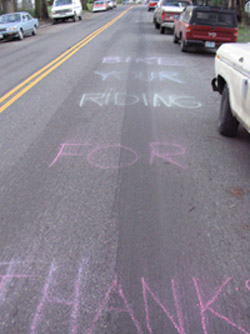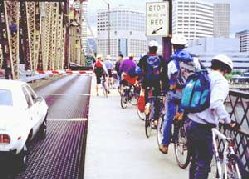Biking in Portland
 From the Bicycle Eye Blog.
From the Bicycle Eye Blog.Scott Batson of Portland's Dept. of Transportation writes "For your reading pleasure, news of biking and bike safety in Portland", with links to two interesting articles about biking in Portland, one from the Portland Oregonian, and the other from the local business newspaper:
"Despite deaths, cyclists and drivers strike better balance: The number of riders climbs, but crashes are steady, suggesting safer conditions"
With six bicyclist deaths in four months, dozens of injuries from collisions and a rash of public sniping between cyclists and drivers, it's tempting to say the Portland area has reached a bike safety crisis. Tempting, but wrong. Statistics suggest cycling in the city has become safer. Bridge counts show the number of bicycles on the streets has skyrocketed, yet the number of reported crashes has changed little. That means the chance of being hit while riding has dropped substantially. ... By comparison, pedestrian deaths in Portland over the same period ranged from eight to 20 per year. ...
But the thousands of commuters, recreational pedalers and hard-core fitness riders who course through Portland's core every day represent a burgeoning middle that has become more adept at coexisting with motorists. This group, decked in business togs, cutoffs or the latest techno-gear, has given Portland its reputation as one of the most bicycle-friendly cities in the nation. The recognition is no accident, city transportation officials say. Over the past decade, Portland has added more than 100 miles of bike lanes and bike paths. That corresponds with a steep increase in the number of riders.
 Hawthorne Bridge, Portland. Bicyclists stopped at a stoplight. Photo from www.altaplanning.com.
Hawthorne Bridge, Portland. Bicyclists stopped at a stoplight. Photo from www.altaplanning.com."A passion for pedaling: Commuters switch gears, turn to bikes for transportation"
With its downtown location, Veloshop, a combination bicycle repair and accessories store, naturally serves its share of bike messenger and racing customers. Lately, though, owner Molly Cameron has fielded a newer breed of patron: white-collar customers who, having ridden into work, leave their bikes for repairs while they do their 9-to-5 thing.
"I'm getting tons of commuters in here," said Cameron, of his store at 211 S.W. 9th Ave. "It's a great range of people, and I'm working on all kinds of bikes." Like most within the biking industry, Cameron believes a confluence of factors will deliver even more business his way. Rising gas prices, growing traffic concerns, and the area's keen awareness of economic and environmental issues have made biking the transportation mode of choice among a growing number of Portland business types. ...
Other business types have noticed the allure of biking. In the Lloyd District, for instance, building owner Ashforth-Pacific has spent vast sums on bike lockers, racks and cages for tenants. Kaiser Permanente offers secure bicycle lockers and ample shower facilities for riders. The state of Oregon has installed bicycle maintenance stations. And the Bonneville Power Administration's bike loaner program allows employees to borrow two-wheelers for the weekend. "We've seen a remarkable commitment to promoting bicycling in the district," said Moira Green, program manager for the Lloyd District Transportation Management Association, which promotes bicycling to area commuters. Many downtown employers promote it, too. During the morning rush hour, the Hawthorne Bridge's east end teems with riders jostling for position.
The number of riders making the trek over the city's four bridges with immediate downtown access has tripled over the last 10 years, according to the city's transportation bureau. The riders can lay claim to some 269 miles of developed bikeways, which Portland officials say compares favorably with similarly sized cities. Commuting bikers will also don their Lycra in September during the annual Bike Commute Challenge. During last year's challenge, nearly 500 companies tracked daily bicycle trips to and from the office.
_________
Interesting articles.



0 Comments:
Post a Comment
<< Home